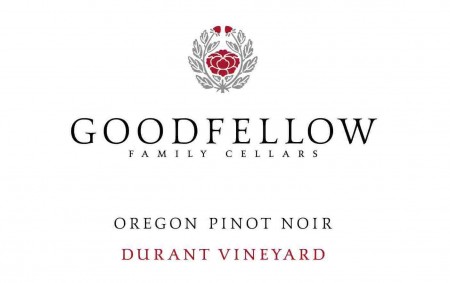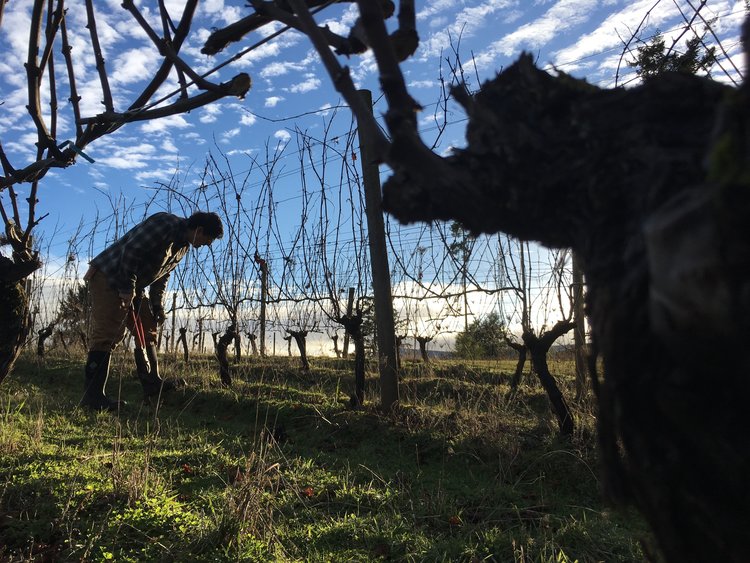Goodfellow Family Cellars, Willamette Valley
California Sales Only

| Region | Oregon |
| Appellation(s) | Primarily Ribbon Ridge |
| Producer | Marcus Goodfellow |
| Founded | 2002 (Goodfellow Family Cellars launched in 2014) |
| Website | goodfellowfamilycellars.com/ |
Marcus Goodfellow makes some of the most elegant and precise New World Pinot Noirs that I know of… The Pinots (and Chardonnays) are distinctly taut and precise, and they rarely hit above 13.5% alcohol. I cannot recommend them highly enough to readers who prize this style.
–Josh Raynolds, Vinous Media, February 2022
Marcus Goodfellow grew up on a Douglas Fir tree farm in Oregon. He got the wine bug in college while working in restaurants, first in Los Angeles and later in Portland, and it was very influenced by the old world. His wine education began in 2002 when he worked the harvest at Evesham Wood and made his first wines in the old Westrey Wine Company building, next door to Eyrie’s old building, in McMinneville’s granary district. He subsequently made three more vintages there, and he credits Westrey founders Amy Wesselman and David Autrey with encouraging and enabling him to begin his own production (then labeled exclusively as Matello Wines).

He also credits Cristom’s Steve Doerner with inspiring him, above all with his openness and honesty. His relationship with Doerner cemented his decision to work with stems, or whole cluster fermentations, and Doerner helped guide him down the path of trusting Mother Nature to handle fermentations just fine with a minimum of interference.
His most important vineyard site is Whistling Ridge, a 14-acre site on a ridge rising just above the Beaux Frères vineyard (they’re adjacent, now separated by a fence). The vineyard was established in 1990 by Richard and Patricia Alvord, who did their own grafting, which proved better than nursery grafting; and planted without irrigation, which led to a Darwinian result of survival of the fittest vines. Marcus met the couple in 1994, did some work in the vines and helped during a harvest, and in 2004 purchased his first batch of Pinot Noir grapes. In subsequent years, this grew to include Pinot Gris, and then Chardonnay in 2010 (when a winery bowed out of its commitment just before harvest because the vintage was deemed too cold). The last two of the five blocks followed in 2013, and now the vineyard is a monopole of Goodfellow Cellars.
Marcus, and his partner in crime at Goodfellow, Megan Joy, make the farming decisions. They have been restricting canopy growth for years now, plus farming no-till, and the result has been pHs averaging a comparatively low 3.4 (ie, good acidity) with alcohols ranging from 11.9 to 12.6 for whites and 12.1 to 13.5 for Pinot Noir. Whistling Ridge is organic, but not certified. Soils are shallow marine sediments, and the site is relatively flat, undulating ridgetop ground that faces mostly southeast.
As of 2021, the other Goodfellow sources are four acres in the Temperance Hill Vineyard in Eola-Amity and three acres from Durant Vineyard in the Dundee Hills. Previously, Marcus has sourced Lewman Vineyard in Eola-Amity and Fir Crest in Yamhill-Carlton, among others.
These days, he likes to do his Pinot Noir fermentations with 30, 50, or 100% whole cluster, depending on the vineyard source and the vintage conditions (grapes from deep, rich volcanic soils, for example, respond well to a higher percentage of whole cluster, while hotter vintages typically take less whole cluster). He lets them go through long, cool extractions and doesn’t add yeast. There’s no temperature control, no use of enzymes, no pump overs, no cold soaks, no oak chips, minimal sulfur, and no fining. The end results are Pinot Noirs with striking aromatics and dense, savory flavors. They ask for a couple of years in bottle. They demand a proper meal.
His whites are a varied bunch but all are intense, transparent wines–and quite rich without being heavy or clumsy. They display excellent acidities and minerality (he prefers sedimentary soils for his white grapes because the top soil tends to be merely a shallow layer above the bedrock).

Marcus works only with farmers he likes and trusts, and who tend their vineyards personally rather than relying on vineyard management companies. For him, wine is a deeply personal matter. He’s a stickler about dry-farmed vineyards. He prefers windy cool sites with good airflow and drainage. He likes ground watched over by a faithful grower which in turn translates into wine with distinct personality.
In 2014 Marcus had his first child. Maybe it was this that motivated him to launch a new label, Goodfellow Family Cellars, a more serious and somber label that he originally dedicated to his production of Oregon’s traditional varieties, primarily from single sites. These days Marcus bottles everything under the Goodfellow label; Matello has been retired. Marcus is shifting things in his cellar too by raising his wines more and more in large, mostly neutral 500-liter and 820-liter barrels in place of the standard 225/228-liter Burgundian barrels. This kind of aging is another step toward emphasizing purity of fruit and transparency of site.
He works with vines from some 21 acres, and makes an average of 4,000 cases annually.
The Wines
| Wine | Blend | Description |
|---|---|---|
| Pinot Gris, Ribbon Ridge | Pinot Gris | Vines grow at highest elevation, sharing thin soils (12-14 inches of topsoil), exposure to the most wind especially at night, exposure to somewhat less direct sunlight, and both sites are harvested early in the morning. The result is a Pinot Gris with excellent acidity and freshness. Several yeast strains are used during fermentation for complexity, and the wine is aged on its lees for seven months in older barrel and tank. Production averages 350 cases annually. |
| Pinot Noir, Willamette Valley | Pinot Noir | This is mostly Whistling Ridge fruit. Fermentation is spontaneous with roughly 40% whole clusters. Ages entirely in French oak (almost all older) for some 17 months before bottling without fining or filtration. Production varies, centering around 750 cases. |
| Whistling Ridge Vineyard "Clover," Ribbon Ridge | Pinot Gris | The top Pinot Gris from Marcus, made in the style of white Burgundy. This is raised in neutral oak barrels and acacia puncheons (500L) and foudres (860L) for roughly 14 months, the year depending. Pressed whole cluster, spontaneous fermentation. ML typically is completed entirely, the vintage depending. 155 cases annually. |
| Whistling Ridge Vineyard Blanc, Ribbon Ridge | Riesling, Pinot Blanc, Pinot Noir, and Gewurztraminer | From the top of the ridge. All harvested at once and co-fermented in neutral oak barrels. This retains lovely acidity and transparent minerality and is surprisingly age-worthy. Production averages 80 cases annually. |
| Whistling Ridge Vineyard "Richard's Cuvée," Ribbon Ridge | Chardonnay | Richard Alvord and his wife Patricia own and farm this 15-acre hilltop vineyard in Ribbon Ridge AVA, the smallest of Oregon's AVAs. Alvord, a WWII pilot, originally planted this site in 1990 and named it for the breeze that whistles through the vineyard every afternoon. The Chardonnay parcel has four clones--76, 96, Espiguette and 108--and covers 1 acre of shallow marine sediments (maybe 10 inches of top soil) above the Beaux Frères vineyard. Regardless of the varietal, this site always gives intense fruit--the wind, shallow soil, and dry farming ensure that. 250 cases annually. |
| Whistling Ridge Vineyard Pinot Noir, Ribbon Ridge | Pinot Noir | Marcus first made this wine in 2014, when he became the only buyer for the Pinot Noir coming off of the Whistling Ridge Vineyard. This is a blend of those barrels (mostly 500-liters) that don't make the cut for the single-vineyard bottling. |
| Fir Crest Vineyard Pinot Noir, Yamhill-Carlton | Pinot Noir | Fircrest Vineyard sits in the coastal foothills in the far southwest corner of the Yamhill-Carlton AVA. Soils are older sedimentary series, aspect of the slope is south-east, and the vines were planted in 1985. The vineyard totals 14 acres and Marcus buys from 1.25 acres. There are various clones planted, but what Marcus gets is all Wadensvile. He makes the wine with native yeast, lots of stems, and ages it in 500-liter demi-muids (about one-third new) for up to twenty months. The wines are deeply colored, intense, rich, and powerful, reminiscent of an Oregon version of Clos de La Roche--dark-fruited but retaining excellent acidity. Production averages just over 100 cases. |
| Durant Vineyard Pinot Noir, Dundee Hills | Pinot Noir | Durant is one of the pioneer vineyards, planted with Pommard stock in 1973 and a second section with clone 114 in 1993. Elevation midpoint is 400 feet in the Dundee Hills AVA, a relatively warm AVA where the soils are volcanic (Jory) and iron-rich, imparting a silkiness to the wine. Fermentation is spontaneous and done with some 50% whole clusters; aging takes place in French barrels, roughly 15% new, and the wine is typically bottled without fining or filtration. 175 cases annually. |